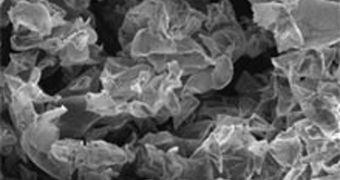Ultracapacitors are energy-storing devices that can both absorb and release electricity very fast. However, they can only store very little energy inside. A group of American researchers may have fixed this issue, with a little help from a heavily-researched carbon compound.
The science team, based at Nanotek Instruments in Dayton, Ohio, used the single-atom-thick compound graphene to boost the energy density of ultracapacitors five times over that of commercially-available devices of this type.
One of the main proposed uses for ultracapacitors is as power units for electric cars. They charge rapidly, are cheap to manufacture, and are safer than the other energy-storage devices.
But they also hold only a measly 5 percent of the electricity that can be stored in lithium-ion batteries, and this made them impractical for real-life applications. This could all change thanks to the new study.
The Nanotek Instruments team developed a way on incorporating tiny, crumpled sheets of graphene into ultracapacitors, a move that allowed the devices to store more energy due to increased surface area.
The carbon compound is currently touted as one of the most important and useful materials ever discovered. It was first obtained in 2005 at the University of Manchester, and the team that managed to do this got the 2010 Nobel Prize in Physics.
Graphene has the same electrical conductivity as copper, but is also the strongest material ever developed. When rolled up, it can create nearly unbreakable carbon nanotubes, so the range of applications it can be used for is staggering.
Experts behind the new work used this 2D material to create advanced electrodes, which they then installed on ultracapacitors. The end result was a device with a substantially-increased energy-storage capability, Technology Review reports.
“We are trying to bridge the performance gap between an ultracapacitor and a lithium-ion battery,” explains the lead author of the new investigation, Bor Jang.
The Nanotek expert and his team published the results of their study in the latest online issue of the esteemed scientific journal Nano Letters.
Using the new technology, the group developed a coin-sized ultracapacitor that is capable of storing as much as 85.6 watt-hours of energy per kilogram inside its graphene electrodes.
A real-life device featuring such electrodes could obtain an average energy density of 28 watt-hours per kilogram, as opposed to the current average levels of just 5 to 10 watt-hours per kilogram.
But the team still has a long way to go until it can match the performances of lithium-ion batteries, which still lead the way with an average energy density of 120 watt-hours per kilogram.

 14 DAY TRIAL //
14 DAY TRIAL //